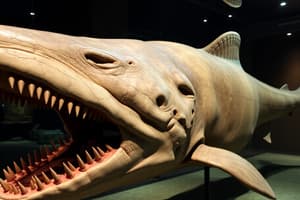Podcast
Questions and Answers
What does the Theory of Natural Selection primarily explain?
What does the Theory of Natural Selection primarily explain?
- How organisms create new environmental features.
- How individuals voluntarily choose their traits.
- The process of individuals adapting and changing within populations. (correct)
- Why all organisms have identical traits and characteristics.
What phrase is often associated with the concept of Natural Selection?
What phrase is often associated with the concept of Natural Selection?
- Survival of the fittest. (correct)
- Survival of the largest.
- Survival of the smartest.
- Survival of the weakest.
Which of the following best describes a key observation that led Darwin to the Theory of Natural Selection?
Which of the following best describes a key observation that led Darwin to the Theory of Natural Selection?
- Only the largest organisms can survive in any environment.
- Most organisms are exactly the same in traits.
- All organisms have evolved from a single source.
- Organisms differ in traits, leading to varying success in survival. (correct)
What can be inferred about organisms with traits better suited to their environment?
What can be inferred about organisms with traits better suited to their environment?
How did Darwin's observations during his journey contribute to his theory?
How did Darwin's observations during his journey contribute to his theory?
What is the scientific name of the megalodon?
What is the scientific name of the megalodon?
During which geological epoch do megalodon fossils date back to?
During which geological epoch do megalodon fossils date back to?
Which type of fossil is created through physical compression and retains organic material?
Which type of fossil is created through physical compression and retains organic material?
What method can be used to date fossils by comparing the layers of rocks?
What method can be used to date fossils by comparing the layers of rocks?
What is the largest division of the geological time scale called?
What is the largest division of the geological time scale called?
Which method is utilized to determine the age of rocks via radioactive isotope decay?
Which method is utilized to determine the age of rocks via radioactive isotope decay?
Comparative anatomy investigates the anatomical similarities and differences among which entities?
Comparative anatomy investigates the anatomical similarities and differences among which entities?
Fossils that represent the hard parts of organisms are generally found in which type of rock?
Fossils that represent the hard parts of organisms are generally found in which type of rock?
What distinguishes homologous structures from analogous structures?
What distinguishes homologous structures from analogous structures?
Which of the following is an example of an analogous structure?
Which of the following is an example of an analogous structure?
Which of the following describes Lamarck's theory of Use and Disuse?
Which of the following describes Lamarck's theory of Use and Disuse?
How did Darwin's view on evolution differ from Lamarck's?
How did Darwin's view on evolution differ from Lamarck's?
Which statement best exemplifies the theory of Acquired Characteristics according to Lamarck?
Which statement best exemplifies the theory of Acquired Characteristics according to Lamarck?
What evidence does genetic information provide in the study of evolution?
What evidence does genetic information provide in the study of evolution?
What role does natural selection play in the evolution of species according to Darwin?
What role does natural selection play in the evolution of species according to Darwin?
Which of the following best describes a characteristic of homologous structures?
Which of the following best describes a characteristic of homologous structures?
Flashcards are hidden until you start studying
Study Notes
Megalodon and Fossils
- Megalodon (Carcharocles megalodon) is the largest shark and fish known to have existed.
- Its fossils date from the early Miocene Epoch (23 million years ago) to the end of the Pliocene Epoch (2.6 million years ago).
- A significant megalodon tooth was discovered in Maribujok, Bohol in July 2020.
Fossil Formation
- Fossils are preserved traces of past organisms, mainly found in sedimentary rocks and often consist of hard body parts like bones, teeth, or shells.
- There are two main types of fossils:
- Impression (Imprint): Shallow external molds with little or no organic material.
- Compression: Fossils preserved in sedimentary rock through physical compression, retaining more organic material.
Determining Fossil Age
- Relative Dating: Compares rock layers to determine relative ages; fossils in lower layers are assumed older than those above.
- Carbon-14 Dating: Uses radioactive decay of isotopes to date fossils.
- The geologic time scale categorizes Earth's history into Precambrian, Paleozoic, Mesozoic, and Cenozoic eras, further divided into periods.
Comparative Anatomy
- Comparative anatomy studies anatomical similarities and differences among species using bone structures.
- Homologous structures: Share a common origin but may perform different functions (e.g., forelimbs of various mammals).
- Analogous structures: Have similar functions but differ in origin (e.g., wings of birds and insects).
Genetic Evidence
- Genetic information consists of nucleotides and proteins crucial for heredity.
- Biochemical analysis, including amino acid sequences, supports evolutionary connections among organisms.
- DNA comparisons reveal relationships among species, showcasing their shared ancestry.
Theories of Evolution
-
Jean Baptiste de Lamarck:
- Proposed organisms change over time in response to environmental needs (Theory of Need).
- Introduced the Theory of Use and Disuse, suggesting unused organs diminish, leading to changes in species.
- The Theory of Acquired Characteristics proposed that traits acquired during an organism's life could be passed to offspring (e.g., giraffes stretching their necks).
-
Charles Darwin:
- Supported the idea of change in organisms over time, emphasizing natural variation.
- Developed the Theory of Natural Selection, explaining how traits enable some individuals to survive and reproduce better ("survival of the fittest").
- Noted diversity among organisms, contributing to his understanding of natural selection and adaptation.
Natural Selection Process
- Natural selection involves individuals within a population varying in traits, leading to differential survival based on environmental fitness.
- Organisms best suited to their environment have the highest chances of survival and reproduction, driving evolutionary change.
Engagement and Observation
- Observational activities can include analyzing footprints to infer information about organisms and relate findings to the Theory of Natural Selection, fostering an understanding of adaptation and survival in varying conditions.
Studying That Suits You
Use AI to generate personalized quizzes and flashcards to suit your learning preferences.




